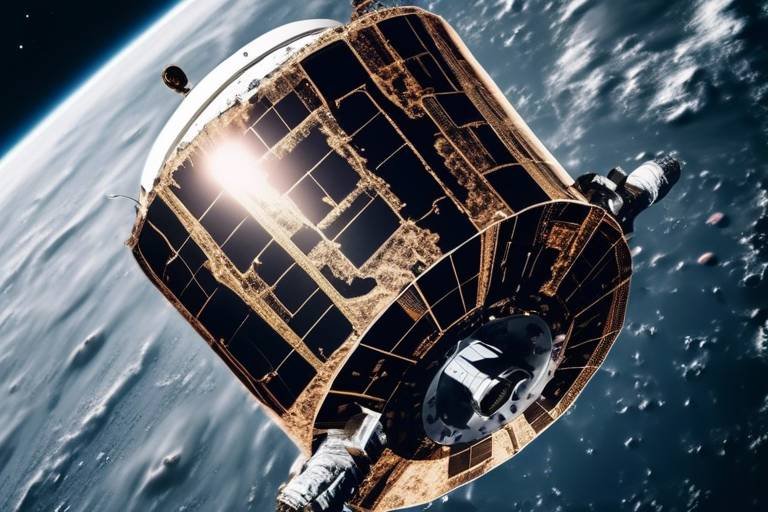Role of AI in Modern Renewable Energy Systems
In a world where energy demands are skyrocketing and environmental concerns are at the forefront, the role of artificial intelligence (AI) in renewable energy systems is nothing short of revolutionary. Imagine a world where energy is not only abundant but also efficiently managed to minimize waste and environmental impact. This is not just a dream; it's a reality that's unfolding right before our eyes as AI technologies are integrated into renewable energy systems. By enhancing efficiency, optimizing resource management, and contributing to sustainability goals, AI is transforming how we harness and utilize energy from sources like solar, wind, and hydro.
Let’s dive deeper into the various ways AI is making waves in the renewable energy sector. From intelligent energy management systems that can predict demand and optimize supply to advanced predictive maintenance techniques that help keep equipment running smoothly, the impact of AI is profound. It’s as if AI is the conductor of an orchestra, harmonizing the various elements of renewable energy to create a symphony of efficiency and sustainability.
One of the most significant contributions of AI is its ability to analyze vast amounts of data quickly and accurately. This capability allows energy providers to make informed decisions that can lead to increased output and reduced costs. For instance, AI can forecast energy production based on weather patterns, ensuring that energy is available when it’s needed most. Additionally, AI-driven tools can optimize energy storage systems, ensuring that excess energy generated during peak production times is stored effectively for later use.
Moreover, AI plays a crucial role in the integration of renewable energy into our existing energy grids. With the rise of smart grids, AI can facilitate real-time data analysis and decision-making, improving the distribution and reliability of renewable energy resources. This means fewer blackouts and a more stable energy supply, which is essential as we transition to a greener future.
As we explore the potential of AI in renewable energy, it's essential to understand the broader implications of these technologies. Not only do they help in meeting the growing energy demands, but they also pave the way for a more sustainable future. By reducing reliance on fossil fuels and minimizing the carbon footprint, AI is not just a tool but a partner in our quest for a cleaner planet.
In summary, the role of AI in modern renewable energy systems is multifaceted, impacting everything from energy management and predictive maintenance to smart grid integration and environmental assessments. As we continue to innovate and explore new technologies, the synergy between AI and renewable energy will undoubtedly play a pivotal role in shaping a sustainable future for generations to come.
- What is the main role of AI in renewable energy? AI enhances efficiency, optimizes resource management, and contributes to sustainability goals in renewable energy systems.
- How does AI improve energy management? AI predicts demand, optimizes supply, and balances loads, leading to increased efficiency and reduced costs.
- What is predictive maintenance? Predictive maintenance uses AI technologies to analyze data and predict equipment failures, allowing for timely interventions.
- How does AI contribute to smart grid integration? AI facilitates real-time data analysis and decision-making, improving the distribution and reliability of renewable energy resources.
- Can AI help in environmental impact assessments? Yes, AI tools assist in assessing the environmental impacts of renewable energy projects, enabling informed decisions that align with sustainability goals.

AI-Driven Energy Management
This article explores how artificial intelligence is transforming renewable energy systems, enhancing efficiency, optimizing resource management, and contributing to sustainability goals in the face of growing energy demands.
Artificial intelligence is revolutionizing energy management in ways that were once thought to be the stuff of science fiction. Imagine a world where energy consumption is perfectly balanced with energy production, where resources are utilized to their fullest potential, and where costs are minimized. This is not just a dream; it’s becoming a reality thanks to AI. By analyzing vast amounts of data in real-time, AI systems can predict energy demand with remarkable accuracy, allowing for proactive adjustments in energy supply. This leads to not only increased efficiency but also a significant reduction in operational costs.
One of the most exciting aspects of AI-driven energy management is its ability to optimize supply. Traditional methods often struggle with the unpredictability of renewable energy sources like solar and wind. However, AI algorithms can forecast weather patterns and energy production levels, enabling energy providers to adjust their output accordingly. For instance, if a storm is predicted to hit an area, AI can suggest ramping up energy storage ahead of time, ensuring that consumers have a steady supply even during outages. This dynamic balancing act is akin to a conductor leading an orchestra, ensuring that every instrument plays harmoniously together.
Moreover, AI enhances load balancing, which is crucial for maintaining grid stability. By analyzing consumption patterns across different sectors—residential, commercial, and industrial—AI can identify peak usage times and redistribute energy loads to prevent blackouts. Think of it as a traffic management system for electricity, where AI directs energy flows to where they are most needed, effectively smoothing out the bumps in energy demand.
To illustrate the impact of AI in energy management, consider the following table that highlights key benefits:
| Benefit | Description |
|---|---|
| Increased Efficiency | AI optimizes energy supply and demand, reducing waste and enhancing overall system performance. |
| Cost Reduction | By predicting demand and optimizing resources, AI helps lower operational costs significantly. |
| Enhanced Reliability | Real-time adjustments ensure a steady supply of energy, even during unexpected fluctuations. |
As we move forward, the integration of AI in energy management will only grow stronger. With the increasing complexity of energy systems and the urgent need for sustainability, AI stands out as a beacon of hope. It not only helps in achieving sustainability goals but also ensures that we are prepared for the future energy demands of our planet. So, the next time you flip a switch, remember that there’s a good chance AI is working behind the scenes to make sure the light comes on without a hitch.
- What is AI-driven energy management? AI-driven energy management utilizes artificial intelligence to predict energy demand, optimize supply, and balance loads, resulting in enhanced efficiency and reduced costs.
- How does AI improve renewable energy systems? AI improves renewable energy systems by analyzing data in real-time, allowing for proactive management of energy resources and ensuring a stable supply.
- What are the benefits of using AI in energy management? Key benefits include increased efficiency, cost reduction, and enhanced reliability of energy supply.
- Can AI predict energy demand accurately? Yes, AI can analyze historical data and current trends to predict energy demand with remarkable accuracy, allowing for better resource management.

Predictive Maintenance in Renewable Energy
In the fast-evolving landscape of renewable energy, predictive maintenance has emerged as a game-changer. By leveraging advanced AI technologies, organizations can now anticipate equipment failures before they happen, thereby reducing downtime and extending the lifespan of their renewable energy assets. Imagine a wind turbine that can alert operators about potential mechanical issues before they escalate into costly repairs. This is not just a dream; it's a reality made possible through data-driven insights and real-time monitoring.
At the heart of predictive maintenance lies the power of machine learning algorithms. These sophisticated algorithms analyze historical data from renewable energy systems to identify patterns that may indicate impending failures. For instance, if a solar panel's output suddenly drops, the system can correlate this with past performance data and environmental factors to predict whether maintenance is required. This proactive approach not only minimizes disruptions in energy production but also significantly enhances operational efficiency.
Machine learning algorithms are the backbone of predictive maintenance in renewable energy. By sifting through vast amounts of historical data, these algorithms can pinpoint specific indicators that suggest when equipment might fail. This allows maintenance teams to intervene before a breakdown occurs. For example, in a solar farm, if the algorithm detects a consistent decrease in output from a specific panel, it can trigger an alert for maintenance personnel to inspect the panel before it affects overall energy generation.
To fuel these machine learning models, advanced data collection techniques are employed. Internet of Things (IoT) sensors play a crucial role in gathering real-time data from various renewable energy assets. These sensors monitor everything from temperature and vibration levels to energy output and weather conditions. The data collected is then fed into machine learning models, enhancing their predictive capabilities. This synergy between data collection and machine learning not only improves maintenance schedules but also optimizes the overall performance of renewable energy systems.
The financial implications of implementing predictive maintenance are substantial. By reducing unplanned outages and minimizing repair costs, organizations can significantly lower their operational expenses. According to a recent study, companies that adopted predictive maintenance strategies reported a 20-30% reduction in maintenance costs. This is a remarkable saving that can be redirected towards further innovation in renewable energy technologies. In addition, by ensuring that equipment operates at peak efficiency, organizations can maximize their energy output, contributing to their bottom line while also supporting sustainability goals.
In summary, predictive maintenance is not just about fixing things before they break; it's about creating a smarter, more efficient renewable energy ecosystem. As we continue to face growing energy demands and environmental challenges, the role of AI in predictive maintenance will only become more critical. By harnessing the power of data and machine learning, we can ensure that our renewable energy systems are not only reliable but also sustainable for generations to come.
- What is predictive maintenance? Predictive maintenance is a proactive approach to maintenance that uses data analysis and machine learning to predict when equipment failures might occur, allowing for timely interventions.
- How does AI contribute to predictive maintenance? AI analyzes historical data and identifies patterns that indicate potential equipment failures, enabling organizations to address issues before they lead to downtime.
- What are the benefits of predictive maintenance in renewable energy? The benefits include reduced downtime, lower operational costs, extended equipment lifespan, and enhanced energy production efficiency.
- What role do IoT sensors play in predictive maintenance? IoT sensors collect real-time data from renewable energy assets, which is crucial for feeding machine learning models that predict maintenance needs.

Machine Learning Algorithms
When we talk about , we're diving into the heart of how artificial intelligence is reshaping the landscape of renewable energy. These algorithms are like the brain of a smart system, analyzing vast amounts of historical data to forecast when equipment might fail. Imagine having a crystal ball that not only predicts the future but also helps us make informed decisions today. This predictive capability is crucial because it allows energy providers to intervene before issues escalate, ensuring a steady flow of energy production.
At the core of these algorithms lies the ability to learn from patterns. They sift through data from various sources, such as wind turbines and solar panels, identifying trends that humans might overlook. For instance, if a wind turbine has a history of underperforming during certain weather conditions, the algorithm can flag this, allowing maintenance teams to proactively address the issue. This is not just about fixing things; it's about enhancing efficiency and maximizing output. By predicting potential failures, organizations can schedule maintenance during low-demand periods, thus minimizing disruptions and optimizing resource allocation.
Furthermore, the integration of Internet of Things (IoT) devices plays a pivotal role in feeding these machine learning models with real-time data. Think of IoT sensors as the eyes and ears of the system, constantly monitoring equipment health and environmental conditions. This data is invaluable, as it provides the raw material that algorithms need to refine their predictions. For example, if a solar panel's output drops unexpectedly, the system can analyze surrounding environmental factors, such as cloud cover or temperature changes, to determine whether the issue is mechanical or simply a result of external conditions.
One of the most exciting aspects of machine learning algorithms in renewable energy is their impact on operational costs. By implementing predictive maintenance strategies, organizations can significantly reduce the costs associated with unplanned outages and emergency repairs. According to various studies, companies that adopt these technologies can see a reduction in maintenance costs by up to 30%. This is not just a number; it translates to substantial savings that can be reinvested into further sustainability initiatives or technological advancements.
In conclusion, machine learning algorithms are not just a buzzword; they are the backbone of modern renewable energy systems. By harnessing their predictive power, energy providers can enhance efficiency, reduce costs, and ultimately contribute to a more sustainable future. As we continue to innovate and integrate these technologies, the potential for renewable energy systems to thrive becomes increasingly promising.

Data Collection Techniques
In the realm of renewable energy, serve as the backbone of effective AI implementation. With the rise of the Internet of Things (IoT), we now have an arsenal of advanced tools that gather real-time data from various sources. Imagine a bustling city where every streetlight, solar panel, and wind turbine communicates vital information back to a central hub. This is the power of IoT in action, and it significantly enhances the predictive capabilities of machine learning models.
One of the most prominent techniques involves the use of IoT sensors. These devices are strategically placed across renewable energy installations to monitor parameters such as temperature, humidity, and energy output. By continuously collecting data, these sensors provide a steady stream of information that is crucial for analyzing the health of equipment and predicting potential failures. For instance, a solar farm equipped with these sensors can instantly alert operators if a panel is underperforming, allowing for immediate troubleshooting before a minor issue escalates into a major problem.
Another noteworthy technique is remote sensing, which employs satellite and aerial imagery to gather data on large-scale renewable energy projects. This approach is invaluable for assessing land use, vegetation health, and environmental impact. By analyzing this data, stakeholders can make informed decisions about site selection and project design, ensuring that renewable energy initiatives align with ecological considerations. The integration of remote sensing with AI not only enhances the accuracy of data analysis but also speeds up the decision-making process, which is crucial in today's fast-paced energy landscape.
Furthermore, data aggregation platforms play a pivotal role in synthesizing information from various sources. These platforms compile data from IoT sensors, remote sensing technologies, and existing databases, creating a comprehensive view of energy production and consumption. By utilizing advanced analytics, these platforms can identify patterns and trends that might otherwise go unnoticed. For example, they can reveal seasonal variations in energy output, helping operators to optimize their strategies accordingly.
To illustrate the significance of these data collection techniques, consider the following table that outlines the various methods and their respective benefits:
| Data Collection Technique | Description | Benefits |
|---|---|---|
| IoT Sensors | Devices that monitor real-time conditions of renewable energy assets. | Immediate alerts for maintenance, improved operational efficiency. |
| Remote Sensing | Use of satellite and aerial imagery for data collection. | Informed site selection, environmental impact assessment. |
| Data Aggregation Platforms | Systems that compile data from multiple sources. | Comprehensive insights, enhanced predictive analytics. |
In conclusion, the integration of these advanced data collection techniques is a game-changer for renewable energy systems. They not only provide the necessary data for machine learning algorithms but also empower organizations to make data-driven decisions that enhance efficiency and sustainability. As we continue to embrace AI in the energy sector, the importance of robust data collection methods will only grow, paving the way for a greener and more sustainable future.
- What are IoT sensors? IoT sensors are devices that collect real-time data from renewable energy installations, helping to monitor their performance and health.
- How does remote sensing aid renewable energy projects? Remote sensing uses satellite and aerial imagery to assess land use and environmental impacts, facilitating informed decision-making.
- What are data aggregation platforms? These platforms compile data from various sources, providing comprehensive insights that enhance predictive analytics in renewable energy systems.

Impact on Operational Costs
In the fast-paced world of renewable energy, operational costs can significantly impact the overall profitability and sustainability of projects. The integration of artificial intelligence (AI) has emerged as a game-changer in this regard. By implementing AI-driven predictive maintenance, organizations can effectively lower their operational costs associated with unplanned outages and repairs. This proactive approach not only minimizes downtime but also extends the lifespan of renewable energy assets.
Consider this: traditional maintenance strategies often rely on scheduled checks, which can lead to unnecessary expenses and equipment failures that could have been avoided. In contrast, AI leverages data analytics to monitor equipment health in real-time, identifying potential issues before they escalate into costly problems. For instance, a wind turbine that undergoes predictive maintenance can avoid a significant failure, which might otherwise result in a lengthy outage and expensive repairs.
To illustrate the financial impact, let’s take a look at a hypothetical scenario:
| Scenario | Traditional Maintenance Cost | AI-Predictive Maintenance Cost |
|---|---|---|
| Annual Maintenance Costs | $100,000 | $60,000 |
| Unplanned Outages (per year) | 5 | 1 |
| Cost of Unplanned Outages | $250,000 | $50,000 |
| Total Annual Costs | $350,000 | $110,000 |
As shown in the table, the shift from traditional maintenance practices to AI-driven strategies can lead to substantial savings. The total annual costs drop from $350,000 to just $110,000, which is a staggering reduction of over 68%. This example underscores the financial benefits of adopting AI technologies in the renewable energy sector.
Moreover, with the continuous advancements in AI and machine learning, the potential for operational cost reduction will only grow. As organizations harness the power of data, they can make more informed decisions on resource allocation, equipment upgrades, and overall operational strategies. This not only leads to immediate cost savings but also positions companies favorably for future growth and sustainability in a competitive market.
In conclusion, the impact of AI on operational costs in renewable energy systems is profound. By embracing predictive maintenance and leveraging real-time data, organizations can significantly reduce their expenses, enhance equipment reliability, and ultimately contribute to a more sustainable energy future.
- What is predictive maintenance? Predictive maintenance is a proactive approach to maintaining equipment by using data analysis to predict when maintenance should be performed, rather than relying on a fixed schedule.
- How does AI help in reducing operational costs? AI helps reduce operational costs by predicting equipment failures, optimizing maintenance schedules, and minimizing downtime, which all contribute to lower overall expenses.
- Can AI improve the lifespan of renewable energy assets? Yes, by using predictive maintenance and real-time monitoring, AI can help extend the lifespan of renewable energy assets by addressing potential issues before they become serious problems.
- What are the long-term benefits of using AI in renewable energy? Long-term benefits include reduced operational costs, improved efficiency, enhanced sustainability, and better compliance with regulations.

AI in Energy Storage Solutions
In the ever-evolving landscape of renewable energy, energy storage solutions have emerged as a crucial element in ensuring a reliable and sustainable energy supply. The integration of artificial intelligence (AI) into these storage systems is nothing short of revolutionary. By optimizing the charging and discharging processes, AI not only enhances the efficiency of energy storage but also maximizes the lifespan of batteries. Imagine a world where energy is not just generated but stored and utilized at peak efficiency—this is the promise of AI in energy storage.
One of the primary ways AI contributes to energy storage is through the optimization of battery management systems. These systems are responsible for monitoring battery health and performance, and AI algorithms can analyze vast amounts of data to predict the best times to charge or discharge energy. For instance, during periods of low energy demand, AI can recommend charging the batteries, while during peak demand, it can suggest discharging energy to the grid. This dynamic management ensures that energy is always available when needed, reducing waste and improving overall system reliability.
Furthermore, AI can help in forecasting energy needs based on historical data and real-time analytics. By understanding consumption patterns, AI can make informed decisions about how much energy should be stored and when it should be released. This predictive capability is akin to having a crystal ball for energy management, allowing operators to stay one step ahead of demand fluctuations. The result? A more resilient energy system that can adapt to changing conditions efficiently.
Additionally, the integration of AI with Internet of Things (IoT) technology plays a vital role in enhancing energy storage solutions. IoT devices can collect real-time data on energy usage, weather conditions, and grid status, feeding this information into AI algorithms. This synergy allows for a more holistic view of energy management, where AI can make real-time adjustments based on current conditions. For example, during a storm, AI can prioritize energy distribution to critical infrastructure, ensuring that essential services remain operational.
Moreover, the impact of AI on operational costs cannot be overstated. By optimizing energy storage processes, organizations can significantly reduce costs associated with energy waste and equipment maintenance. A well-managed energy storage system not only saves money but also contributes to a more sustainable future by reducing reliance on fossil fuels and minimizing carbon emissions.
As we look to the future, the role of AI in energy storage solutions will only continue to grow. With advancements in machine learning and data analytics, we can expect even more sophisticated systems that will transform how we think about energy management. The potential for AI to create a more sustainable and efficient energy landscape is immense, making it an exciting area of innovation in the renewable energy sector.
- What is the role of AI in energy storage solutions?
AI optimizes the charging and discharging processes of energy storage systems, improving efficiency and maximizing battery lifespan.
- How does AI enhance battery management systems?
AI algorithms analyze data to predict the best times for charging and discharging, ensuring energy is used efficiently.
- Can AI help reduce operational costs in energy storage?
Yes, by optimizing processes and minimizing energy waste, AI can significantly lower operational costs.
- What is the synergy between AI and IoT in energy storage?
IoT devices collect real-time data that AI uses to make informed decisions about energy management.

Smart Grid Integration
In today's rapidly evolving energy landscape, the concept of a smart grid has become a pivotal element in harnessing the full potential of renewable energy systems. Smart grids leverage artificial intelligence (AI) to facilitate real-time data analysis and decision-making, which ultimately enhances the distribution and reliability of renewable energy resources. Imagine a network that not only distributes electricity but also learns and adapts to the changing needs of consumers and the environment. This is the essence of smart grid integration.
AI plays a crucial role in streamlining the complexities of energy distribution. By analyzing vast amounts of data from various sources, AI algorithms can identify patterns in energy consumption, predict peak usage times, and even forecast renewable energy generation based on weather conditions. This capability allows grid operators to optimize energy flow, ensuring that supply meets demand efficiently. For instance, during peak hours, AI can automatically adjust the distribution of energy from solar panels or wind turbines to where it’s needed most, minimizing waste and improving overall system efficiency.
Moreover, the integration of AI into smart grids facilitates demand response management. This innovative approach involves adjusting energy distribution dynamically based on real-time consumption patterns. When demand spikes, AI can signal distributed energy resources to ramp up production or encourage consumers to reduce usage through incentives. This not only enhances grid stability but also empowers consumers to take an active role in energy management. The result? A more resilient and responsive energy system that benefits everyone.
However, the benefits of smart grid integration extend beyond just efficiency and reliability. With AI's ability to monitor and analyze data continuously, it contributes significantly to enhanced grid security. In a world where cyber threats are increasingly prevalent, AI can identify vulnerabilities in the grid and predict potential attacks before they occur. By implementing robust security measures driven by AI insights, grid operators can safeguard renewable energy systems, protecting them from disruptions that could have far-reaching consequences.
To illustrate the impact of AI in smart grid integration, consider the following table that highlights key benefits:
| Benefit | Description |
|---|---|
| Efficiency | Optimizes energy distribution based on real-time data. |
| Reliability | Improves energy supply stability through predictive analytics. |
| Security | Enhances grid protection against cyber threats. |
| Consumer Empowerment | Encourages active participation in energy management. |
In conclusion, the integration of AI into smart grids represents a significant leap forward in the management of renewable energy systems. By leveraging advanced technologies, we can create a more efficient, reliable, and secure energy landscape. As we continue to face growing energy demands and environmental challenges, smart grid integration will be essential in achieving our sustainability goals and ensuring a cleaner, greener future for generations to come.
- What is a smart grid? A smart grid is an electricity supply network that uses digital technology to monitor and manage the transport of electricity from all generation sources to meet the varying electricity demands of end users.
- How does AI improve smart grid efficiency? AI analyzes real-time data to optimize energy distribution, predict demand, and manage resources effectively, leading to reduced waste and improved efficiency.
- What role does AI play in grid security? AI enhances grid security by identifying vulnerabilities and predicting potential cyber threats, allowing for proactive measures to protect the energy system.
- Can consumers influence energy distribution in a smart grid? Yes, through demand response programs, consumers can adjust their energy usage based on real-time data, helping to balance supply and demand.

Demand Response Management
Demand Response Management (DRM) is a game changer in how we approach energy consumption and distribution. Imagine a world where energy usage is not just a static number but a dynamic, responsive entity that adapts to real-time conditions. This is the essence of demand response management, powered by artificial intelligence (AI). By leveraging sophisticated algorithms and data analytics, AI can analyze consumption patterns and adjust energy distribution dynamically. It’s like having a smart thermostat that not only knows when to heat or cool your home but also understands when it’s best to do so based on energy availability and cost.
In practical terms, DRM allows utilities to communicate with consumers, encouraging them to reduce or shift their power usage during peak demand periods. This is particularly vital for renewable energy systems, where supply can be intermittent and less predictable compared to traditional energy sources. Think of it as a well-coordinated dance between energy supply and demand, where every participant knows their role and timing. The result? Improved grid stability and reduced reliance on fossil fuels, leading to a more sustainable energy future.
Through AI, utilities can implement programs that incentivize users to lower their energy consumption during peak hours. For instance, when the grid is under stress, households might receive notifications to reduce their usage, perhaps by delaying the use of heavy appliances like washing machines or dishwashers. This not only helps in maintaining grid balance but also empowers consumers to save on their energy bills. The beauty of this system lies in its ability to create a win-win scenario for both energy providers and consumers.
Moreover, AI-driven demand response management can forecast energy demand with impressive accuracy. By analyzing historical data and current usage trends, AI can predict when demand will peak and suggest proactive measures to mitigate it. This predictive capability allows for better resource allocation, ensuring that renewable energy sources, such as solar and wind, are utilized efficiently. For instance, if AI predicts a spike in demand during a hot summer afternoon, it can recommend increased energy production from solar panels, which are typically at their peak during those hours.
In summary, demand response management powered by AI is not just about managing energy; it’s about transforming how we interact with it. It fosters a more resilient and sustainable energy ecosystem, where every kilowatt is used wisely, and every consumer plays a part in shaping the future of energy. As we continue to integrate AI into our energy systems, the potential for innovation and efficiency is limitless, paving the way for a greener planet.
- What is Demand Response Management?
Demand Response Management is a strategy that encourages consumers to adjust their energy usage during peak demand times, helping to maintain grid stability and reduce energy costs.
- How does AI enhance Demand Response Management?
AI analyzes consumption patterns and predicts energy demand, allowing for real-time adjustments in energy distribution and better resource allocation.
- What are the benefits of Demand Response Management?
Benefits include reduced energy costs for consumers, improved grid reliability, and increased utilization of renewable energy resources.
- Can consumers participate in Demand Response programs?
Yes, consumers can participate by adjusting their energy usage based on notifications from utilities during peak demand periods.

Enhanced Grid Security
In an era where the energy landscape is rapidly evolving, the importance of grid security cannot be overstated. As renewable energy sources become more prevalent, the integration of artificial intelligence (AI) into grid systems is revolutionizing how we protect these vital infrastructures. With the rise of smart grids, the potential for cyber threats increases, making it imperative to adopt advanced security measures. AI plays a crucial role in identifying vulnerabilities, predicting potential cyber threats, and ensuring the integrity of renewable energy systems.
One of the most significant advantages of AI in enhancing grid security is its ability to analyze vast amounts of data in real time. Traditional security measures often fall short due to the sheer volume and complexity of data generated by modern energy systems. AI algorithms can sift through this data, identifying patterns and anomalies that might indicate a security breach. For instance, if a particular segment of the grid is experiencing unusual activity, AI can flag this for immediate investigation, allowing for quicker responses to potential threats.
Moreover, AI systems can learn from past incidents, continuously improving their predictive capabilities. By utilizing machine learning, these systems can adapt to new threats as they emerge, ensuring that grid security remains robust against evolving cyberattack techniques. This proactive approach not only minimizes the risk of outages but also protects critical infrastructure from malicious actors.
Another essential aspect of AI in grid security is its ability to facilitate automated responses. In the event of a detected threat, AI can initiate predefined protocols to isolate affected areas of the grid, preventing the spread of potential disruptions. This automation significantly reduces the response time, which is crucial in mitigating the impact of cyberattacks. Additionally, AI can assist in incident reporting by documenting breaches and responses, providing valuable data for future analysis and improvement.
To illustrate the impact of AI on grid security, consider the following table that outlines key benefits:
| Benefit | Description |
|---|---|
| Real-Time Monitoring | AI analyzes data continuously to detect anomalies and threats instantly. |
| Predictive Analysis | Machine learning algorithms identify potential vulnerabilities before they are exploited. |
| Automated Incident Response | AI systems can execute predefined security protocols to mitigate threats quickly. |
| Continuous Improvement | AI learns from past incidents, enhancing its ability to predict and respond to future threats. |
As we continue to integrate renewable energy into our power systems, the role of AI in ensuring grid security will only grow more critical. By leveraging advanced technologies, we can create a more resilient energy infrastructure that not only meets our current demands but also safeguards against future challenges. The synergy between AI and renewable energy systems represents a promising frontier in the quest for a sustainable and secure energy future.
- How does AI improve grid security? AI enhances grid security by analyzing real-time data to identify potential threats and vulnerabilities, allowing for quicker responses to incidents.
- Can AI predict cyber threats? Yes, AI uses machine learning algorithms to analyze historical data and recognize patterns that may indicate future cyber threats.
- What role does automation play in grid security? Automation allows AI systems to execute predefined security protocols rapidly, minimizing the impact of cyberattacks.
- Is AI capable of learning from past security incidents? Absolutely! AI systems continuously learn and adapt based on previous incidents, improving their predictive capabilities over time.

Environmental Impact Assessment
The transition to renewable energy sources is crucial for our planet's sustainability, but it doesn't come without its challenges. Understanding the environmental impacts of these projects is essential to ensure that we are genuinely moving towards a greener future. This is where Artificial Intelligence (AI) steps in, acting as a powerful ally in the assessment process. By leveraging sophisticated algorithms and data analysis, AI tools can provide insights into the ecological effects of renewable energy initiatives, which helps stakeholders make informed decisions.
One of the primary benefits of AI in environmental impact assessments is its ability to analyze vast amounts of data quickly and accurately. This data can include everything from local wildlife populations to soil quality and air pollution levels. For instance, AI can process satellite imagery and sensor data to monitor changes in land use or habitat disruption caused by new solar farms or wind turbines. This kind of analysis not only helps in understanding the immediate impacts but also in predicting long-term ecological consequences.
Moreover, AI-driven data analysis can identify patterns and correlations that might be missed by traditional assessment methods. For example, by analyzing historical weather patterns alongside energy production data, AI can help forecast potential environmental impacts related to climate change. This predictive capability is invaluable for planning future projects that align with sustainability goals while minimizing adverse effects on the environment.
Another significant aspect of AI in environmental impact assessments is its role in regulatory compliance. Navigating the complex web of environmental regulations can be daunting for organizations. AI can automate reporting processes, ensuring that all necessary data is collected and presented in a format that meets regulatory standards. This not only streamlines the compliance process but also enhances transparency, which is crucial for public trust.
To illustrate the impact of AI on environmental assessments, consider the following table that compares traditional methods with AI-enhanced approaches:
| Aspect | Traditional Methods | AI-Enhanced Methods |
|---|---|---|
| Data Processing Speed | Slow, manual analysis | Rapid, automated analysis |
| Data Volume Handling | Limited to small datasets | Capable of processing large datasets |
| Predictive Capabilities | Reactive, based on past events | Proactive, forecasting future impacts |
| Regulatory Compliance | Manual tracking and reporting | Automated compliance monitoring |
As we move forward in our quest for renewable energy, the role of AI in environmental impact assessments will only grow. By providing deeper insights and enhancing compliance, AI not only aids in minimizing negative impacts but also supports the sustainable development of renewable energy projects. The future is bright, and with AI at the helm, we can pave the way for a more sustainable and environmentally friendly energy landscape.
- What is an Environmental Impact Assessment?
An Environmental Impact Assessment (EIA) is a process used to evaluate the potential environmental effects of a proposed project before it is carried out. - How does AI improve Environmental Impact Assessments?
AI enhances EIAs by analyzing large datasets quickly, identifying patterns, and predicting long-term environmental impacts. - Can AI help with regulatory compliance?
Yes, AI can automate the tracking and reporting processes needed to ensure compliance with environmental regulations. - What types of data does AI analyze for environmental assessments?
AI can analyze various data types, including satellite imagery, sensor data, weather patterns, and historical ecological data.

Data Analysis for Sustainability
In the quest for a more sustainable future, data analysis has emerged as a powerful ally, particularly in the realm of renewable energy. By leveraging AI-driven tools, stakeholders can gain valuable insights into the ecological impacts of energy projects, paving the way for informed decision-making. Imagine being able to visualize the potential effects of a solar farm on local wildlife or the water consumption of a wind turbine installation; this is the kind of clarity that data analysis provides.
At the core of this process lies the ability to collect vast amounts of data from various sources. For instance, AI systems can analyze environmental variables such as temperature, humidity, and even local wildlife patterns. This data not only helps in understanding the immediate impacts of renewable energy systems but also aids in forecasting long-term ecological changes. By examining historical data alongside current metrics, organizations can identify trends and make adjustments to their projects, ensuring that they align with sustainability goals.
Moreover, the integration of AI in data analysis allows for real-time monitoring and feedback, which is crucial for adapting to changing environmental conditions. For example, if a solar farm is found to be affecting local bird populations, immediate adjustments can be made to mitigate this impact. This proactive approach not only enhances the sustainability of such projects but also builds trust with communities and stakeholders who are increasingly concerned about environmental conservation.
To illustrate the significance of data analysis in sustainability, consider the following table that summarizes key benefits:
| Benefit | Description |
|---|---|
| Enhanced Decision-Making | Data-driven insights allow for better planning and implementation of renewable energy projects. |
| Reduced Environmental Impact | Real-time monitoring helps in identifying and mitigating negative ecological effects promptly. |
| Regulatory Compliance | Automated data collection and analysis assist in meeting environmental regulations effectively. |
| Stakeholder Engagement | Transparent data sharing fosters trust and collaboration among stakeholders. |
Furthermore, AI tools can automate the reporting processes required for regulatory compliance, ensuring that organizations not only adhere to environmental laws but also demonstrate their commitment to sustainability. This is particularly important as governments and regulatory bodies worldwide are tightening their grip on environmental standards. By utilizing AI for data analysis, companies can stay ahead of compliance requirements and avoid potential penalties.
In conclusion, data analysis powered by AI is not just a trend; it’s a vital component of sustainable energy practices. As we continue to innovate and integrate technology into our energy systems, the ability to analyze and act upon data responsibly will determine the success of our efforts toward a greener planet. So, the next time you hear about a renewable energy project, remember that behind the scenes, data analysis is working tirelessly to ensure that sustainability is not just an afterthought, but a core principle guiding our energy future.
- What role does AI play in renewable energy sustainability? AI helps analyze data to assess environmental impacts, optimize resource use, and ensure compliance with regulations.
- How can data analysis improve renewable energy projects? By providing insights into ecological effects, it enables better planning and helps mitigate negative impacts.
- What are the benefits of using AI for regulatory compliance? AI automates reporting processes, helping organizations meet environmental regulations effectively.
- Can AI predict environmental impacts before project implementation? Yes, AI can analyze historical data and current metrics to forecast potential ecological changes.

Regulatory Compliance
In the ever-evolving landscape of renewable energy, has become a pivotal aspect for organizations striving to align with environmental standards and sustainability goals. With the integration of artificial intelligence (AI), the process of ensuring compliance has transformed significantly. AI tools not only streamline reporting processes but also enhance the accuracy of data collection and analysis. This leads to a more efficient way of tracking sustainability metrics, which is essential for meeting regulatory requirements.
One of the key benefits of AI in regulatory compliance is its ability to automate the tedious and often complex reporting processes. By leveraging machine learning algorithms, organizations can analyze vast amounts of data and generate comprehensive reports that highlight their adherence to environmental regulations. This not only saves time but also reduces the risk of human error, which can lead to costly penalties and reputational damage. Imagine having a digital assistant that meticulously tracks every compliance requirement, ensuring that nothing slips through the cracks—that’s the power of AI in regulatory compliance.
Moreover, AI can help organizations stay ahead of the curve by predicting changes in regulations. With the energy sector facing increasing scrutiny and evolving policies, being proactive rather than reactive is crucial. AI systems can analyze trends and historical data to forecast potential regulatory shifts, allowing organizations to adjust their strategies accordingly. This foresight can be the difference between compliance and non-compliance, making AI an invaluable asset in the renewable energy sector.
To illustrate the impact of AI on regulatory compliance, consider the following table that outlines the traditional compliance challenges versus AI-enhanced solutions:
| Compliance Challenge | Traditional Approach | AI-Enhanced Solution |
|---|---|---|
| Data Collection | Manual data entry and tracking | Automated data gathering through IoT sensors |
| Reporting | Time-consuming and prone to errors | Real-time report generation with high accuracy |
| Regulatory Changes | Reactive adjustments | Predictive analytics for proactive compliance |
| Cost of Non-Compliance | Potential fines and legal issues | Reduced risk through continuous monitoring |
In conclusion, the integration of AI into regulatory compliance processes not only simplifies the task but also enhances the overall effectiveness of compliance strategies in the renewable energy sector. As organizations continue to navigate the complexities of environmental regulations, embracing AI will be crucial in fostering a sustainable future. By automating reporting and proactively managing compliance, companies can focus more on their core mission of generating clean energy while confidently meeting regulatory standards.
- What is regulatory compliance in renewable energy?
Regulatory compliance refers to the adherence to laws, regulations, and guidelines that govern the renewable energy sector, ensuring that organizations operate within legal frameworks and contribute to sustainability goals. - How does AI improve regulatory compliance?
AI improves regulatory compliance by automating data collection and reporting processes, enhancing accuracy, and providing predictive analytics to anticipate regulatory changes. - What are the benefits of using AI for compliance reporting?
The benefits include time savings, reduced risk of human error, real-time insights, and the ability to stay ahead of regulatory changes.
Frequently Asked Questions
- How does AI improve renewable energy management?
AI enhances renewable energy management by predicting energy demand, optimizing supply chains, and balancing loads. This leads to increased efficiency and reduced operational costs, making energy systems smarter and more responsive to changing needs.
- What is predictive maintenance and how does AI play a role?
Predictive maintenance uses AI technologies to analyze data from renewable energy assets, predicting when equipment failures might occur. This allows for proactive maintenance, reducing downtime and extending the lifespan of equipment, ultimately saving costs.
- Can AI help with energy storage solutions?
Absolutely! AI optimizes the charging and discharging processes in energy storage systems, ensuring energy is available when needed while maximizing battery lifespan. This is crucial for balancing supply and demand in renewable energy systems.
- What is the role of AI in smart grid integration?
AI facilitates smart grid integration by enabling real-time data analysis and dynamic decision-making. This improves the distribution and reliability of renewable energy resources, ensuring that energy flows smoothly and efficiently across the grid.
- How does AI enhance grid security?
AI enhances grid security by identifying vulnerabilities and predicting potential cyber threats. This proactive approach helps ensure the integrity of renewable energy systems, protecting them from malicious attacks and ensuring stable energy supply.
- What is the significance of environmental impact assessment in renewable energy projects?
Environmental impact assessments are crucial for understanding the ecological effects of renewable energy projects. AI tools assist in this process by providing data-driven insights, helping stakeholders make informed decisions that align with sustainability goals.
- How does AI assist with regulatory compliance in renewable energy?
AI helps organizations ensure compliance with environmental regulations by automating reporting processes and tracking sustainability metrics effectively. This reduces the burden on teams and ensures that organizations meet their legal obligations.



















